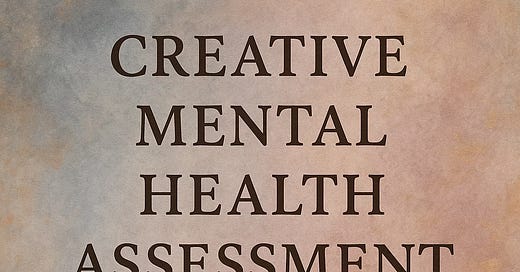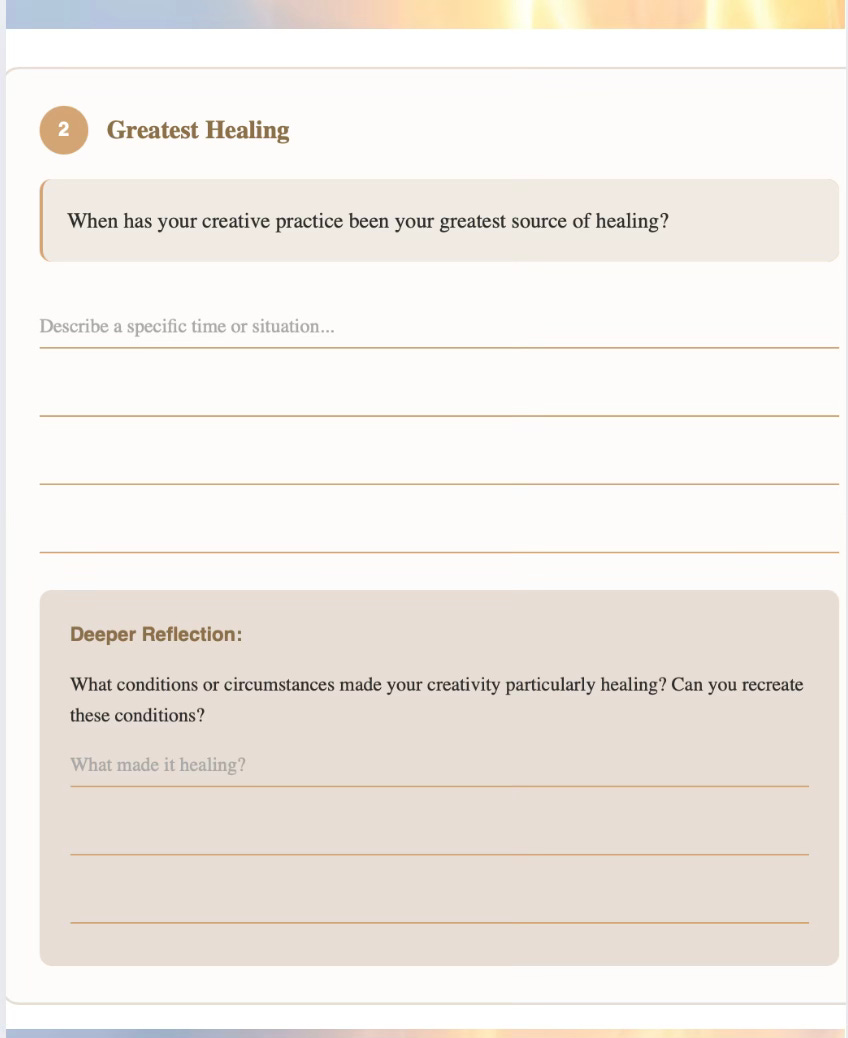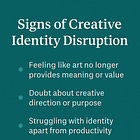Listening to Your Creative Self and How It Intersects with Health: A Workbook
The Creative Mental Health Self-Assessment Workbook is about building self-understanding around how your creative process is affected by your mental, emotional, and physical well-being.
As a writer-artist who has spent years exploring the intersection of creativity and mental health, both in my own practice and in the lives of the artists I support, I’ve learned that creative block is rarely just about the work itself. More often, it reflects a deeper entanglement with issues of identity, energy, grief, neurobiology, and life transition. Our creative practices are not separate from the rest of our lives. They are shaped and sometimes constrained by our emotional states, physical capacities, beliefs about worth and value, and by the cultural narratives we’ve internalized about what it means to be productive or successful.
Yet so often, when creative people reach a point of difficulty or disconnection, they are given advice that ignores these complexities. They are told to power through. To try a thirty-day challenge. To make a schedule and stick to it. To push past resistance. This advice may be well-meaning, but it often fails to address the real root of the pause. And more dangerously, it can reinforce shame when it doesn’t work. If you're already in a fragile or uncertain place, being told to just do the work can feel like an indictment of your character or discipline rather than a recognition of your current reality.
This is why I created the Creative Mental Health Self-Assessment Workbook. Not to tell you what’s wrong. Not to optimize you. Not to give you another productivity framework. Instead, it is a mirror that invites you to explore how your creative life and your internal world are speaking to one another. It is rooted in the belief that awareness is not just the first step toward change, but a meaningful practice in and of itself.
The Purpose of This Workbook
At its heart, this workbook is about building self-understanding around how your creative process is affected by your mental, emotional, and physical well-being. Many artists have never been given the space to explore these intersections in any structured way. While some people develop this awareness through years of trial, therapy, or somatic practice, others simply know they feel blocked or overwhelmed and do not yet have language for what is happening.
The workbook offers a series of reflective prompts that encourage you to name the patterns you are living through. How does your energy fluctuate across a week, a season, or a year? What conditions support a creative flow state for you, and what reliably interrupts it? Where does perfectionism sneak in, and where might you be clinging to an outdated version of your creative identity that no longer fits who you are becoming?
These questions are not meant to be answered quickly. In fact, many of them are intentionally open-ended because what matters is not the correctness of your answer, but the quality of your attention. This workbook does not assume you need to be more productive. It assumes you are already trying very hard, and it trusts that if you can slow down long enough to hear yourself clearly, a gentler, more sustainable rhythm will begin to emerge.
Why I Offer This Before a Session
When someone schedules a 1:1 session with me, I often send this workbook as a pre-session resource. Not as homework or a requirement, but as an optional companion.
For some people, this kind of reflection is deeply grounding. It gives shape to their thoughts and allows them to enter the session with clarity about what they want to explore. For others, the very idea of a workbook feels overwhelming, especially when they are already navigating fatigue, anxiety, executive dysfunction, or creative shame. That is okay. I tell each person to use it however feels right. Read a few questions. Let them sit in the back of your mind. Write in the margins. Ignore whole sections. There is no correct way to engage.
The key is that the workbook is not an obligation. It is an offering. And for those who do choose to use it, it can serve as a bridge between the murkiness of something’s not working and the deeper insights that begin to arise when we create space for reflection.
Sneak Peek
What’s Inside and How to Use It
The workbook is organized into several areas of inquiry that I often explore in session: process, content, medium, productivity, identity, and the relationship between creativity and health. You will find questions like:
What kind of creative rhythm feels possible for you right now, given the life you are actually living?
What does your creative practice offer you emotionally, somatically, spiritually, and are there other ways to access those feelings in times when art-making feels difficult?
What stories do you hold about what makes a real artist, and how do those stories serve or limit you?
What has your creative work helped you survive, and how might your needs be shifting now?
These are complex questions. My hope is that the workbook becomes a living document, something you return to during different seasons of your life. Some people keep it by their art table or bed. Others revisit it annually, as a check-in. Some work through it during times of transition: a move, a diagnosis, a career pivot, or a return to creativity after a long pause.
There is no timeline. There is no expectation.
You might find yourself writing paragraphs in response to one question and skipping the next three. You might find that your answers change drastically depending on your emotional state that day. That variability is part of the work. You are allowed to be inconsistent. You are allowed to shift.
A Gentle Invitation
If you are reading this and feel drawn to the idea of deepening your awareness around your creative health, I want you to know this workbook is available to you. You do not need to be a client. You do not need to be in crisis. You do not need to prove anything about your seriousness or legitimacy as an artist.
The Creative Mental Health Self-Assessment Workbook is free to download and use however serves you best.
It is yours to keep. To explore slowly. To set aside. To return to months later when something clicks. It is a tool, but also a companion. And I hope that in some small way, it helps you feel less alone.
If you do find that the questions surface more than you expected, whether it be grief, longing, clarity, or a desire to speak it out, I am here. My 1:1 sessions are designed to hold exactly that. But this workbook stands on its own. It is complete without needing to lead anywhere.
Start wherever you are. Stay curious. Let the pace be slow.
And know that listening to yourself, really listening, is one of the most powerful creative acts you can do.










Thank you!!
This is spectacular. Thank you. I'm already using the workbook!!